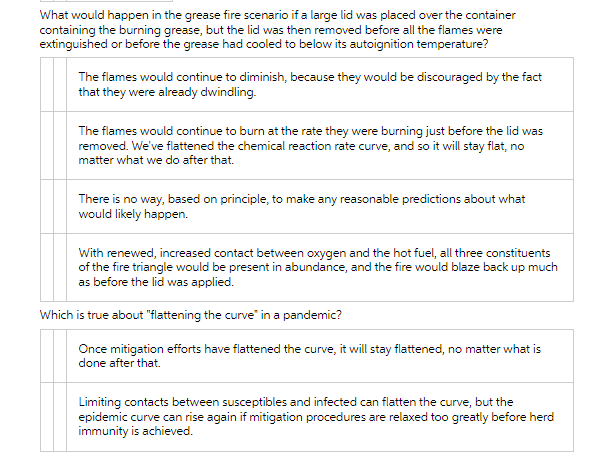What would happen in the grease fire scenario if a large lid was placed over the container containing the burning grease, but the lid was then removed before all the flames were extinguished or before the grease had cooled to below its autoignition temperature? The flames would continue to diminish, because they would be discouraged by the fact that they were already dwindling. The flames would continue to burn at the rate they were burning just before the lid was removed. We've flattened the chemical reaction rate curve, and so it will stay flat, no matter what we do after that. There is no way, based on principle, to make any reasonable predictions about what would likely happen. With renewed, increased contact between oxygen and the hot fuel, all three constituents of the fire triangle would be present in abundance, and the fire would blaze back up much as before the lid was applied. Which is true about "flattening the curve" in a pandemic? Once mitigation efforts have flattened the curve, it will stay flattened, no matter what is done after that. Limiting contacts between susceptibles and infected can flatten the curve, but the epidemic curve can rise again if mitigation procedures are relaxed too greatly before herd immunity is achieved.
What would happen in the grease fire scenario if a large lid was placed over the container containing the burning grease, but the lid was then removed before all the flames were extinguished or before the grease had cooled to below its autoignition temperature? The flames would continue to diminish, because they would be discouraged by the fact that they were already dwindling. The flames would continue to burn at the rate they were burning just before the lid was removed. We've flattened the chemical reaction rate curve, and so it will stay flat, no matter what we do after that. There is no way, based on principle, to make any reasonable predictions about what would likely happen. With renewed, increased contact between oxygen and the hot fuel, all three constituents of the fire triangle would be present in abundance, and the fire would blaze back up much as before the lid was applied. Which is true about "flattening the curve" in a pandemic? Once mitigation efforts have flattened the curve, it will stay flattened, no matter what is done after that. Limiting contacts between susceptibles and infected can flatten the curve, but the epidemic curve can rise again if mitigation procedures are relaxed too greatly before herd immunity is achieved.
Chemistry for Engineering Students
4th Edition
ISBN:9781337398909
Author:Lawrence S. Brown, Tom Holme
Publisher:Lawrence S. Brown, Tom Holme
Chapter9: Energy And Chemistry
Section: Chapter Questions
Problem 9.102PAE: 9.102 A runner generates 418 kJ of energy per kilometer from the cellular oxidation of food. The...
Related questions
Question

Transcribed Image Text:What would happen in the grease fire scenario if a large lid was placed over the container
containing the burning grease, but the lid was then removed before all the flames were
extinguished or before the grease had cooled to below its autoignition temperature?
The flames would continue to diminish, because they would be discouraged by the fact
that they were already dwindling.
The flames would continue to burn at the rate they were burning just before the lid was
removed. We've flattened the chemical reaction rate curve, and so it will stay flat, no
matter what we do after that.
There is no way, based on principle, to make any reasonable predictions about what
would likely happen.
With renewed, increased contact between oxygen and the hot fuel, all three constituents
of the fire triangle would be present in abundance, and the fire would blaze back up much
as before the lid was applied.
Which is true about "flattening the curve" in a pandemic?
Once mitigation efforts have flattened the curve, it will stay flattened, no matter what is
done after that.
Limiting contacts between susceptibles and infected can flatten the curve, but the
epidemic curve can rise again if mitigation procedures are relaxed too greatly before herd
immunity is achieved.
Expert Solution
This question has been solved!
Explore an expertly crafted, step-by-step solution for a thorough understanding of key concepts.
This is a popular solution!
Trending now
This is a popular solution!
Step by step
Solved in 2 steps with 1 images

Knowledge Booster
Learn more about
Need a deep-dive on the concept behind this application? Look no further. Learn more about this topic, chemistry and related others by exploring similar questions and additional content below.Recommended textbooks for you

Chemistry for Engineering Students
Chemistry
ISBN:
9781337398909
Author:
Lawrence S. Brown, Tom Holme
Publisher:
Cengage Learning

Chemistry: Principles and Practice
Chemistry
ISBN:
9780534420123
Author:
Daniel L. Reger, Scott R. Goode, David W. Ball, Edward Mercer
Publisher:
Cengage Learning

Principles of Modern Chemistry
Chemistry
ISBN:
9781305079113
Author:
David W. Oxtoby, H. Pat Gillis, Laurie J. Butler
Publisher:
Cengage Learning

Chemistry for Engineering Students
Chemistry
ISBN:
9781337398909
Author:
Lawrence S. Brown, Tom Holme
Publisher:
Cengage Learning

Chemistry: Principles and Practice
Chemistry
ISBN:
9780534420123
Author:
Daniel L. Reger, Scott R. Goode, David W. Ball, Edward Mercer
Publisher:
Cengage Learning

Principles of Modern Chemistry
Chemistry
ISBN:
9781305079113
Author:
David W. Oxtoby, H. Pat Gillis, Laurie J. Butler
Publisher:
Cengage Learning

Chemistry & Chemical Reactivity
Chemistry
ISBN:
9781133949640
Author:
John C. Kotz, Paul M. Treichel, John Townsend, David Treichel
Publisher:
Cengage Learning

Chemistry & Chemical Reactivity
Chemistry
ISBN:
9781337399074
Author:
John C. Kotz, Paul M. Treichel, John Townsend, David Treichel
Publisher:
Cengage Learning

Introductory Chemistry: A Foundation
Chemistry
ISBN:
9781337399425
Author:
Steven S. Zumdahl, Donald J. DeCoste
Publisher:
Cengage Learning